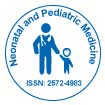Unsere Gruppe organisiert über 3000 globale Konferenzreihen Jährliche Veranstaltungen in den USA, Europa und anderen Ländern. Asien mit Unterstützung von 1000 weiteren wissenschaftlichen Gesellschaften und veröffentlicht über 700 Open Access Zeitschriften, die über 50.000 bedeutende Persönlichkeiten und renommierte Wissenschaftler als Redaktionsmitglieder enthalten.
Open-Access-Zeitschriften gewinnen mehr Leser und Zitierungen
700 Zeitschriften und 15.000.000 Leser Jede Zeitschrift erhält mehr als 25.000 Leser
Indiziert in
- Google Scholar
- RefSeek
- Hamdard-Universität
- EBSCO AZ
- ICMJE
Nützliche Links
Open-Access-Zeitschriften
Teile diese Seite
Abstrakt
Congenital Heart Disease in the Newborn and Importance of EarlyIntervention
Kendalem Atalell
Although prenatal diagnostic techniques have improved significantly, the accurate detection and appropriate treatment of newborns with congenital heart disease (CAD) has always been of great interest to pediatricians. Congenital heart malformations range from benign to serious conditions such as: Prompt diagnosis and treatment are necessary if the baby is to survive. Unfortunately, these life-threatening heart conditions may not be apparent early in life and most clinical and physical findings are nonspecific and equivocal, making diagnosis difficult. Decisions require a high suspicion index and keen insight. Many serious malformations can go unnoticed early in life when the patent ductus arteriosus (PDA) is wide open, but can become severe as the PDA contracts hours to days later. It can lead to acidosis/shock/cyanosis or even death. Conduit-dependent congenital heart lesions, which can be classified as conduit-dependent systemic or pulmonary diseases, are physiologically very different from each other and therapeutic strategies should be tailored to the clinical condition and cardiac malformation. Unavoidable early onset is often considered a medical emergency. Differential diagnoses include congenital metabolic disorders, neonatal sepsis, neonatal persistent pulmonary hypertension (PPHN), and other pulmonary diseases. Urgent identification of these atrisk neonates requires timely referral to a pediatric cardiologist, and timely intervention is key to reducing mortality and morbidity. The overview below describes the clinical manifestations, assessment, and treatment of congenital heart defects that manifest early in life.
Zeitschriften nach Themen
- Allgemeine Wissenschaft
- Biochemie
- Chemie
- Genetik und Molekularbiologie
- Geologie und Geowissenschaften
- Immunologie und Mikrobiologie
- Klinische Wissenschaften
- Krankenpflege und Gesundheitsfürsorge
- Landwirtschaft und Aquakultur
- Lebensmittel & Ernährung
- Maschinenbau
- Materialwissenschaften
- Medizinische Wissenschaften
- Pharmazeutische Wissenschaften
- Physik
- Sozial- und Politikwissenschaften
- Umweltwissenschaften
- Veterinärwissenschaften
Klinische und medizinische Fachzeitschriften
- Anästhesiologie
- Augenheilkunde
- Betrieb
- Dermatologie
- Diabetes und Endokrinologie
- Gastroenterologie
- Genetik
- Gesundheitspflege
- Immunologie
- Infektionskrankheiten
- Kardiologie
- Klinische Forschung
- Medizin
- Mikrobiologie
- Molekularbiologie
- Neurologie
- Onkologie
- Pädiatrie
- Pathologie
- Pflege
- Toxikologie
- Zahnheilkunde

 English
English  Spanish
Spanish  Chinese
Chinese  Russian
Russian  French
French  Japanese
Japanese  Portuguese
Portuguese  Hindi
Hindi